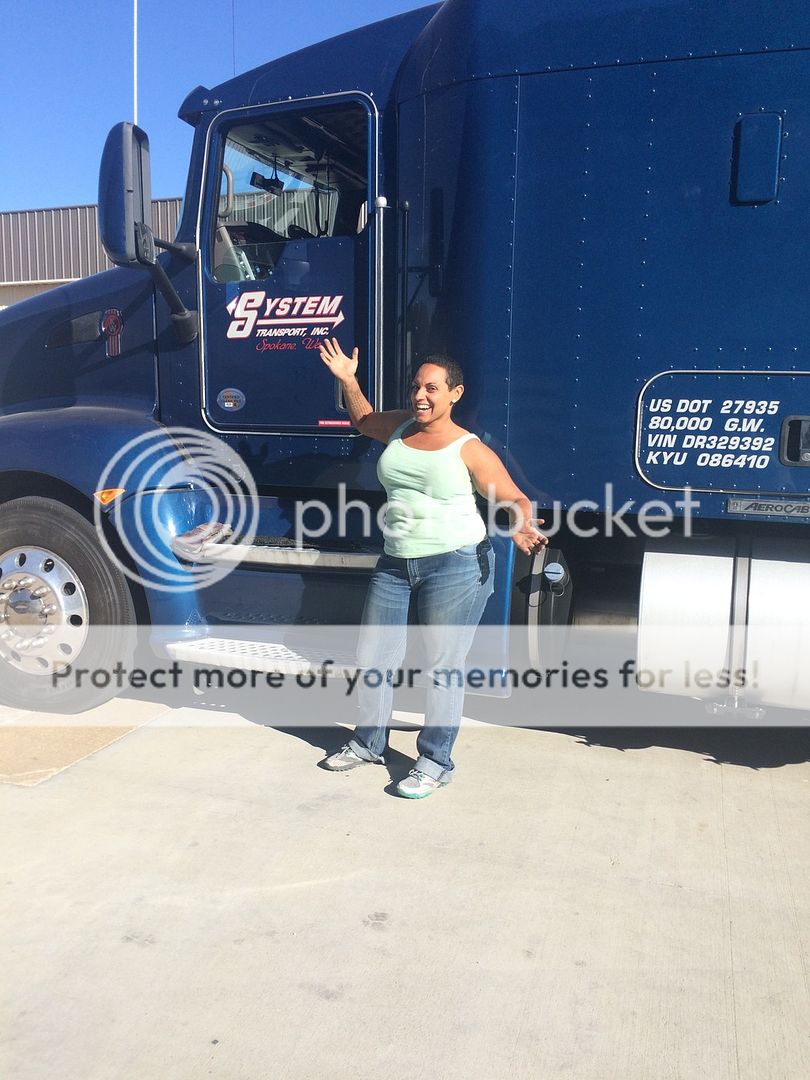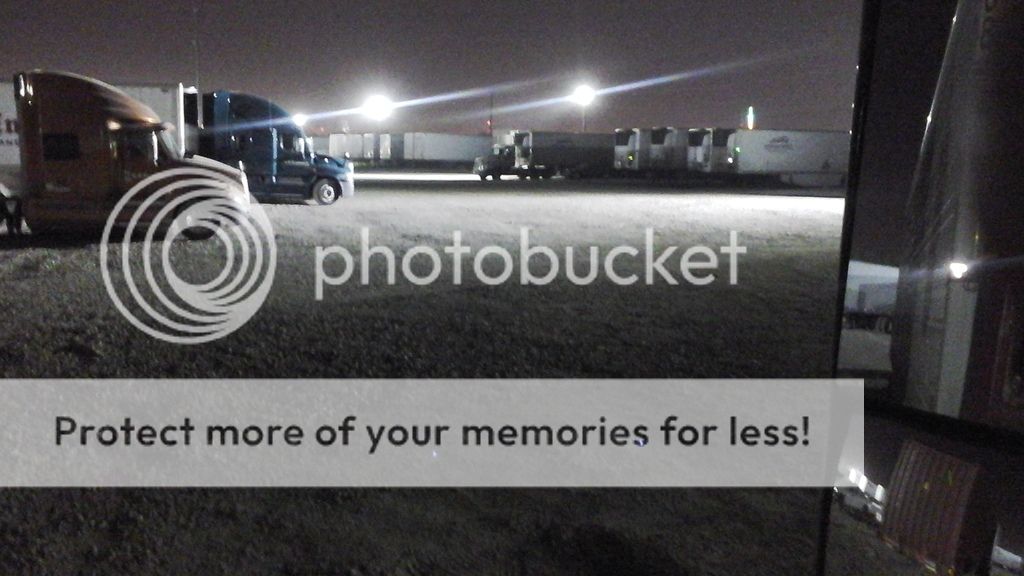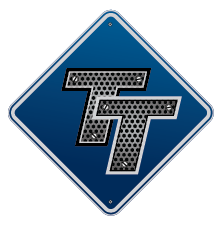For Your Reading Pleasure
Topic 9147 | Page 1

(continued...I can write a lot)
The recruiter at the first school was really helpful. He answered a lot of questions and clarified the process of getting trained up and ready to drive. The cost was average, the trucks were average, and it was really close to the interstate (making it easier to commute). The instructors have an incredible amount of experience and I liked the classroom set-up. BUT, it has a 3-1 student-instructor ratio for drive-time.
The second school was actually having a job fair in addition to an informational meeting on the school itself. (If you ever get the change to go to a job fair, DO IT. I made some great contacts and think I found the company I'm going to try to work for. The only reason I say try is because it's a flatbed company and although I think I'll pass the lift-test, I don't want to get too big for my britches.) The facilities are about the same, cost is a little higher, but the trucks are newer. I didn't meet any of the instructors (realistically, a good instructor or trainer is important but my education and training is what I make of it), but the staff is straight forward and helpful. Most importantly (for me), they have 1-1 student-instructor ratio for drive-time. That was the deciding factor. With absolutely zero commercial driving experience and very little manual transmission driving experience, I felt like I needed the extra attention from an instructor. I know that some people learn well in a group setting, but call me selfish...
DOT physical and CDL permit
My timeline is a little out of order, so let me clarify. Before I went to the job fair/info meeting at the second school, but after I visited the first school, I decided that I should get my physical and permit. I had been studying for the permit using the High Road Training Program. Man, I'm glad I did. It truly is the best program and way to pass the permit test. Before I went in for my test though, I got my physical done. I figured, it would be better for me to have my DOT physical card before taking the test because if I passed (which I did ;) ) I could get my card right away. Otherwise, I would have to go back for my permit since the physical is required before they issue the permit. Sometimes it takes money to make money...
Back to the school part....
I called the second school the day after the job fair/info meeting and scheduled a same-day orientation. Before going, I filled out the enrollment app, picked up my MVR , made a copy of my license and CDL temp permit (the card should be coming in the mail within the month), made a copy of my DOT physical long-form, and made a copy of my last college diploma. I got there and she did some quick data entry, signed me up, and sent me over for my drug test. I made it to the clinic three minutes before closing! Perfect timing...
So that's where I leave you! I start school on Monday :) I'm really excited. A little nervous. This isn't the first time I'll (probably) be the only woman in class, but it can be a little nerve-racking.
I'm sure my future entries will be a little more entertaining. The first steps are all business, no fun. ;)
So let the fun begin! 
CDL:
Commercial Driver's License (CDL)
A CDL is required to drive any of the following vehicles:
- Any combination of vehicles with a gross combined weight rating (GCWR) of 26,001 or more pounds, providing the gross vehicle weight rating (GVWR) of the vehicle being towed is in excess of 10,000 pounds.
- Any single vehicle with a GVWR of 26,001 or more pounds, or any such vehicle towing another not in excess of 10,000 pounds.
- Any vehicle, regardless of size, designed to transport 16 or more persons, including the driver.
- Any vehicle required by federal regulations to be placarded while transporting hazardous materials.
DOT:
Department Of Transportation
A department of the federal executive branch responsible for the national highways and for railroad and airline safety. It also manages Amtrak, the national railroad system, and the Coast Guard.
State and Federal DOT Officers are responsible for commercial vehicle enforcement. "The truck police" you could call them.
Interstate:
Commercial trade, business, movement of goods or money, or transportation from one state to another, regulated by the Federal Department Of Transportation (DOT).
MVR:
Motor Vehicle Record
An MVR is a report of your driving history, as reported from your state Department of Motor Vehicles. Information on this report may include Drivers License information, point history, violations, convictions, and license status on your driving record.
Thank you, Melly. I followed a similar path, only it took me 30 additional years of non-career before I took up truck driving. Glad you put most of the details in. That is what makes it useful for others trying to figure out the trucking thing. Thanks again!

Thank you, Melly. I followed a similar path, only it took me 30 additional years of non-career before I took up truck driving. Glad you put most of the details in. That is what makes it useful for others trying to figure out the trucking thing. Thanks again!
Oh goodness! I should be grateful it's only been 10 years then. Sometimes it feels like wasted time, even though I know better. And thank you for all your responses. I've really appreciated your feedback :)
Yup Iike the detailed, outline of the steps ya took, should be of help to others that read it 

The story continues... I posted about how today is my first day driving but before I get into that, let me rewind a little.
I started school two weeks ago. The way the school breaks it down is we have two weeks of classroom training and then we roll into the trucks for drive time. If I had to do it all over again, I would make sure to ask if there was a textbook BEFORE starting class. There was and it was challenging to keep up with the lessons without having previously read the book. I learn better when I read before lecture, but some of you may be fine with not having that. We did have textbooks provided in class but couldn't take them home. I ordered a textbook online and all was well!
Classroom Time
We covered 36 chapters in 10 days. Each day we would have a new set of chapters to discuss and complete the review questions at the end. Some days we would hit 5 chapters, some days only 2. We studied out of the book called Tractor-Trailer Truck Driver Training, 4th edition by Alice Adams. I have had a lot of textbooks in my adult life and I would say that with the exception of some typos, it was a good guide to the excellent classroom instruction. We also received a copy of the Truck Drivers' Bible (FMCSR Safety Manual) with which we had to answer 75 questions. Great book. Read it. It may seem daunting, but it's so important to know as many of the regulations as possible that apply to you as a driver. Safety and Responsibility were drilled into our heads.
The classroom time ran Monday through Friday, 8a to 5p. We would get an hour for lunch and two breaks (one around 10a and one around 3p). This leads me into...
Student Driver Health and Humanity
Use these breaks to reset and talk to other students. That's what I did and it was really great. By talking to the other students, I was able to clearly reflect on why and how I was doing this. As I'm sure you've read in the other threads, this is a lifestyle not a 9-5p job. All my classmates had such fabulous stories on why and how they are choosing to become commercial vehicle operators. For some, it was because of a divorce that is requiring them to push the restart button; others were veterans who drove MCVs while deployed or during their time stationed here; and others were former drivers who were returning to the industry. Everyone has a story and I do my best to learn from them. It will keep you humble and grounded in the reality that everytime you get behind the wheel of a truck, these are the people you're sharing the roads with, the people who are your extended family, the people who - in our own way and through responsible and safe driving habits - we are serving and protecting.
Another part of the student health and humanity is meals and snacks. I always had something to nibble on or eat during these breaks. When you're new to this industry, the information covered can be overwhelming. Letting your blood sugar drop will only work against you, making it difficult to retain the vast amount of information we need to learn. So, pack a lunch and some snacks - boring, low-sugar, high-protein/fiber, snacks. I would eat a Kind bar (nuts etc) and string cheese on the first break, an Amy's microwaveable meal or sandwich at lunch, and then a greek yogurt on the second break.
Maintaining good health is important for us drivers and I figure getting into the practice of it now will help keep me in a healthy place when I start driving.
Drive Time
The next phase of training will start today for me. I'm going to a 1-1, instructor-student ratio school. We have 11 sections and those sections are divided into drive time and range time. The driving courses vary as the instructors take us on different runs which include interstate , city, and mountain driving. The range is used to teach us backing maneuvers, during which we'll cover straight backing, off-set, parallel, and alley dock. The time in which we get the driving portion done and graduate varies based on the number of students (the more students, the longer it might take to get everyone through), and the student's schedule. For instance, I requested no drive time on weekends because I need to be home to get things in order before I head out.
I also plan on bringing plenty of water because it gets pretty hot in that dirt pit!
Interstate:
Commercial trade, business, movement of goods or money, or transportation from one state to another, regulated by the Federal Department Of Transportation (DOT).
Fm:
Dispatcher, Fleet Manager, Driver Manager
The primary person a driver communicates with at his/her company. A dispatcher can play many roles, depending on the company's structure. Dispatchers may assign freight, file requests for home time, relay messages between the driver and management, inform customer service of any delays, change appointment times, and report information to the load planners.HOS:
Hours Of Service
HOS refers to the logbook hours of service regulations.DWI:
Driving While Intoxicated
OOS:
When a violation by either a driver or company is confirmed, an out-of-service order removes either the driver or the vehicle from the roadway until the violation is corrected.

Good luck with everything!
I'm heading to school on the 20th and am excited to start this new chapter in my life. Reading about your journey gives me a break from studying and home prep, but it also is very informative. It really sounds like you thought everything through and did the pros and cons before committing to a school.
The school I'm going to is a company school that hires successful graduates for a specified length of time immediately upon completion. Getting the schooling without having the money to start, this was the only option. The only down side I can see personally is the required MONTHS of team driving. Not looking forward to that! But, having someone to back me up and to back up won't be all bad. (It will be a test of my fortitude. I LIKE my alone time.)
The 1-1 ratio sounds awesome. I remember Driver's Education when I was 14. (Good gravy! I've been driving 30 years!) We had the instructor and 3 students in the car rotating driving every 30 minutes or so. One-to-one is great, but I remember learning a lot from watching the other students and listening to the instructor when they made mistakes and getting corrected. I made sure I was the last student each day. It was like getting 3 times the instruction. I knew what I was doing before even taking the driver's seat!
Hopefully, we'll meet up on the road some day!
All the best,
Renae
Good luck with everything!
I'm heading to school on the 20th and am excited to start this new chapter in my life. Reading about your journey gives me a break from studying and home prep, but it also is very informative. It really sounds like you thought everything through and did the pros and cons before committing to a school.
The school I'm going to is a company school that hires successful graduates for a specified length of time immediately upon completion. Getting the schooling without having the money to start, this was the only option. The only down side I can see personally is the required MONTHS of team driving. Not looking forward to that! But, having someone to back me up and to back up won't be all bad. (It will be a test of my fortitude. I LIKE my alone time.)
The 1-1 ratio sounds awesome. I remember Driver's Education when I was 14. (Good gravy! I've been driving 30 years!) We had the instructor and 3 students in the car rotating driving every 30 minutes or so. One-to-one is great, but I remember learning a lot from watching the other students and listening to the instructor when they made mistakes and getting corrected. I made sure I was the last student each day. It was like getting 3 times the instruction. I knew what I was doing before even taking the driver's seat!
Hopefully, we'll meet up on the road some day!
All the best,
Renae
Congrats on your decision Renae! Please be sure to keep us in the loop on your progress...
But I have to ask this question.... Where in there world do they put a 14 Y.O. in Drivers Ed?  I've always been under the presumption that 15 was the earliest you could begin since you cant test for your license until your 16th birthday....
I've always been under the presumption that 15 was the earliest you could begin since you cant test for your license until your 16th birthday....

Hey there Renae,
I'm glad you found this helpful! There are so many entries like mine, but every story is different. So thanks for reading.
I can totally empathize with the frustration of not knowing where the funds are going to come from. I took a different path by using an interest free credit card and then going with a company that offers tuition reimbursement. But it sounds like you did the right thing for you and that's what matters. Same goes for the ratio of instructors to students.
As for the team driving, I can understand your trepidation. And I'm glad you brought it up because I've been wanting to post about this. I'm getting nervous about having to drive with a trainer for a couple months. So here goes:
Handling a Team/Trainer-Trainee Situation: from the mouth of an inexperience/rookie driver
Driving team can be difficult from all accounts I've read. BUT, I believe, our life experiences are entirely up to us and how we react. I have mulled this over in my head a thousand times on how I'm going to handle this because, at the end of the day, when I finally do get to go solo, I want my trainer and me to fondly remember our days together. My frustration and temper and ego can sometimes flare up all at once and it isn't pretty. So I've learned/am practicing the take-a-step-back-and-breathe approach. Usually all this is directed at myself and people mistake it for being directed at them. I tend to be a perfectionist so when I make a mistake, it takes a minute for me to let it go. This is my biggest worry about driving with a trainer. To counteract the disastrous effects this head space can put me in, I've made "COMMUNICATION" my moto to prepare me for this situation. I figure, nobody is a mind reader and the quickest way to diffuse a tense situation is to calmly explain what is going on in my head. Whether it's something I'm beating myself up over or something they did, or apologizing for something I did, communicating the emotions in a rational and honest manner is the glue that will make a team setting (especially a forced one) functional. These are the steps that I'm going to do my very best to follow when tension arises with my trainer (because it's not a matter of IF but WHEN):
1) Identify the problem
Be it indigestion, hormones, lack of sleep, tone of voice, making a mistake with the rig or route, whatever - the most important thing is to strip all the b.s. away and identify the real reason for the tension. I have found that I tend to project on to other things when really that was just covering up the real issue at hand. So taking 30 minutes (or 4 hours) to do this might not be a bad thing. In my personal life, I have found that when I immediately and negatively react to a situation, a snow ball effect happens. Next thing I know I'm in a full-blown negativity cloud with the person and that's when the real damage is done. So, I'm trying to remember to slow down and think about it before moving on to my next step.
2) Accept my share of responsibility in the situation
I am not perfect. And the sooner I embrace that, the better off I'll be. Every action has a reaction and every reaction has...well, another reaction. So it becomes my responsibility to understand, acknowledge, and accept my role in what is going on. Accepting that my actions played a part in creating my reality is difficult but necessary. It is this step that creates the positive space to grow and learn from every situation. Which leads to...
3) Respectfully communicate
Once I identify the issue and accept my responsibility, it is time to open my mouth and say something - respectfully. Our society often jokes that men aren't mind readers, but the same can be said for women. If I don't open my mouth and communicate I am assuming that the other person knows exactly what is going through my head. Wrong. And we all know what assuming can lead to...So I plan to give whoever I'm with an "in." Having a respectful dialogue, stripped of ego and malice, will do wonders to preserve any relationship; tenfold when the person I'm communicating with is sharing 100 sq ft with me. By calmly and respectfully communicating with a trainer, I will have not only opened the door for improvement and problem solving but have also allowed myself to be vulnerable. Vulnerability isn't a bad thing. It reinforces mutual respect between people. Vulnerability = Speaking my truth NOT weakness. And it will allow them to speak theirs. Note: Just because I'm being respectful, does not guarantee that they will follow suit. So, I must remember in this situation to take the "high road" and not strike back. With this said...
4) Pick my battles
Not everything has to be talked to death. Some things have to be thrown in the river of forgiveness and be allowed to float away! Not every scratch needs a bandaid; sometimes you just have to let it air dry. Maybe this step should be #1. I will do my best to remember that this situation of training/teaming is stressful for all involved and that short fuses might be there. It's up to me to not light them unnecessarily. I must show my trainer the same kindness and forgiveness that I would hope he/she will show me.
Those are my steps! We'll see how well they work ;)
As for meeting up on the road, Renae, you know where to find me :) Best of luck to you and I'll be praying that your team time goes smoothly!
~Sunshine
HOS:
Hours Of Service
HOS refers to the logbook hours of service regulations.OWI:
Operating While Intoxicated

Congrats on your decision Renae! Please be sure to keep us in the loop on your progress...

But I have to ask this question.... Where in there world do they put a 14 Y.O. in Drivers Ed?  I've always been under the presumption that 15 was the earliest you could begin since you cant test for your license until your 16th birthday....
I've always been under the presumption that 15 was the earliest you could begin since you cant test for your license until your 16th birthday....

Idaho. I don't know if the rules changed too much since I got my first driver's license in 1985.
You can't drive at night, but if you take Driver's Ed., you can get a driver's license at 14 1/2 years old.
Of course, I got my license and had no car or insurance and my mother wouldn't let me borrow hers. So, I spent almost 3 years before I could actually do any driving. But danggit! I was legal!
New Reply:
New! Check out our help videos for a better understanding of our forum features

















Preview:








 TT On Facebook
TT On Facebook
Not sure if telling my story will help anyone, but so many of the diaries have been at least entertaining to read that I figured I'd contribute. Maybe my experiences will inspire....
9 years of full-time school, three degrees, and a business later, I feel extremely stuck. I did things out of order in both my personal life and career path. Thinking jobs in the education I received would always be there and pay enough to allow me to thrive was a mistake - one that has cost me dearly. Or has it? Because if it had, I wouldn't be starting down this really exciting path of driving. The past is the past, and I'm starting CDL school on Monday.
A couple months ago, I had to take a cold, hard look at my future. Maybe it's because I'm turning 30 and I am indeed having the existential crisis that I swore I would never have. When I looked ahead, I couldn't see much. At least, not in the way of financial stability or sustainability. I started thinking about the different paths I could take: Go back to doing massage? Grow the cleaning company? Find a part-time office job to work until I could rise in the ranks and make the switch to full-time? Nothing really seemed appealing (for a multitude of reasons - mostly financial). I made the mistake of getting degrees without getting entry level experience, thinking that companies would just hire me right out of school and start me at $40k a year. Not. So, I started thinking about all the other jobs I've done...could I go back to construction and work my way into a foreman position? Become a GM at a quick lube shop? ......All dead ends.
So, I decided to take a realistic inventory of my strengths and weaknesses.
1) I'm good with the general public, but don't have the qualities for managing employees.
2) I'm reliable and employers can count on me to show up on time and ready to work, but I do like my time off.
3) I can laugh at just about anything and turn a bad situation on its head (I guess that falls under problem solving skills)
4) I have pretty thick skin and prefer industries that require hard work, but I don't like dealing with "office politics" and cattiness
5) I have a good driving record and can pass a drug test, but I have no driving experience with commercial vehicles
6) I like a challenge
The list was much longer, but I narrowed it down to a couple things:
1) Welding school - I could go break out my old welding hood and go back to school. Try to get on at a fab shop or in the oil fields
2) X-Ray tech - After almost a decade of higher education, I know that I have the brain to break into the medical industry
3) Truck driving - With my dependability and time management skills, I could be a great driver as long as I got the right training
Needless to say, I choose the third. Hard to put into words why driving appeals to me more than the other two. But when I thought about it, driving truck is something I can do for many years, pays well, is in demand, doesn't cost a lot to become certified, and is challenging enough that it will be fulfilling long-term.
So I called one of my friends who drives for a local food company. He does reefer and is on the regional crew. He told me to come to this website.
I'm so glad he did.
I immediately began reading all the sections on how to get started.I broke everything down into steps.
Pre-hire letters
Before anything else, I decided to make sure I was hire-able. SO I started reaching out to companies for pre-hire letters. Best thing I ever did. I set a goal of 5 pre-hire letters. If this career path is meant to be, I told myself, I'll get at least 5 pre-hires. I now have 8 pre-hires and a wide selection to choose from. I also sent the companies that issued these letters the following questions:
-How long is training? Pay?
-How soon will I be placed with a trainer (as a female driver, I found out that depending on company requirements there can be a wait since they will only place female trainees with female trainers)
-How soon will I be placed in my truck upon completing my training?
-What physical requirements are there?
-How does home time and the 34 hr restart work with the company?
-What is the pay scale (CPM)?
-Does pay cover layover, breakdown, detention, tarping/untarping (for flatbed), border crossing, etc?
-What benefits are offered (tuition reimbursement, etc)?
-Does the company require an employment contract?
-What are the rider/pet policies? Cost?
-How many miles to company drivers average each week?
I'm sure there are other pertinent questions, but those are the ones that I asked. All the recruiters (with the exception of two of the companies) were happy to respond. On to the next step....
Picking a School
As soon as I received my pre-hires, I contacted the schools in my area. Narrowed it down to two schools. Although there are schools in my area (Northern Colorado), I read here on TT (thank you Brett) that even if it means driving for a while, it's better to get good training than go to a school merely for the convenience. We are going to be driving for a living, after all! SO, instead of staying up here, I'm headed down to Denver for school.
I visited two schools (researched 4).....
CDL:
Commercial Driver's License (CDL)
A CDL is required to drive any of the following vehicles:
Regional:
Regional Route
Usually refers to a driver hauling freight within one particular region of the country. You might be in the "Southeast Regional Division" or "Midwest Regional". Regional route drivers often get home on the weekends which is one of the main appeals for this type of route.
CPM:
Cents Per Mile
Drivers are often paid by the mile and it's given in cents per mile, or cpm.
Pre-hire:
What Exactly Is A Pre-Hire Letter?
Pre-hire letters are acceptance letters from trucking companies to students, or even potential students, to verify placement. The trucking companies are saying in writing that the student, or potential student, appears to meet the company's minimum hiring requirements and is welcome to attend their orientation at the company’s expense once he or she graduates from truck driving school and has their CDL in hand.
We have an excellent article that will help you Understand The Pre-Hire Process.
A Pre-Hire Letter Is Not A Guarantee Of Employment
The people that receive a pre-hire letter are people who meet the company's minimum hiring requirements, but it is not an employment contract. It is an invitation to orientation, and the orientation itself is a prerequisite to employment.
During the orientation you will get a physical, drug screen, and background check done. These and other qualifications must be met before someone in orientation is officially hired.
Pre-hires:
What Exactly Is A Pre-Hire Letter?
Pre-hire letters are acceptance letters from trucking companies to students, or even potential students, to verify placement. The trucking companies are saying in writing that the student, or potential student, appears to meet the company's minimum hiring requirements and is welcome to attend their orientation at the company’s expense once he or she graduates from truck driving school and has their CDL in hand.
We have an excellent article that will help you Understand The Pre-Hire Process.
A Pre-Hire Letter Is Not A Guarantee Of Employment
The people that receive a pre-hire letter are people who meet the company's minimum hiring requirements, but it is not an employment contract. It is an invitation to orientation, and the orientation itself is a prerequisite to employment.
During the orientation you will get a physical, drug screen, and background check done. These and other qualifications must be met before someone in orientation is officially hired.
Reefer:
A refrigerated trailer.
HOS:
Hours Of Service
HOS refers to the logbook hours of service regulations.OWI:
Operating While Intoxicated
OOS:
When a violation by either a driver or company is confirmed, an out-of-service order removes either the driver or the vehicle from the roadway until the violation is corrected.